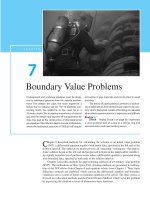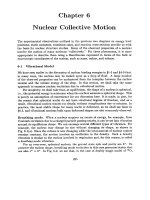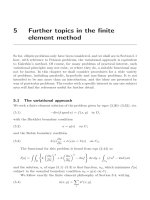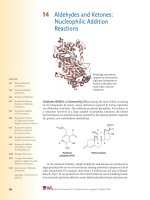Ebook Supramolecular chemistry (2nd edition) Part 1
Bạn đang xem bản rút gọn của tài liệu. Xem và tải ngay bản đầy đủ của tài liệu tại đây (7.88 MB, 570 trang )
Supramolecular
Chemistry
Second Edition
Supramolecular Chemistry, 2nd edition J. W. Steed and J. L. Atwood
© 2009 John Wiley & Sons, Ltd ISBN: 978-0-470-51233-3
Supramolecular
Chemistry
Second Edition
Jonathan W. Steed
Department of Chemistry, Durham University, UK
Jerry L. Atwood
Department of Chemistry, University of Missouri, Columbia, USA
This edition first published 2009
© 2009, John Wiley & Sons, Ltd.
Registered office
John Wiley & Sons Ltd, The Atrium, Southern Gate, Chichester, West Sussex, PO19 8SQ, United Kingdom
For details of our global editorial offices, for customer services and for information about how to apply for permission to
reuse the copyright material in this book please see our website at www.wiley.com.
The right of the author to be identified as the author of this work has been asserted in accordance with the Copyright,
Designs and Patents Act 1988.
All rights reserved. No part of this publication may be reproduced, stored in a retrieval system, or transmitted, in any form
or by any means, electronic, mechanical, photocopying, recording or otherwise, except as permitted by the UK Copyright,
Designs and Patents Act 1988, without the prior permission of the publisher.
Wiley also publishes its books in a variety of electronic formats. Some content that appears in print may not be available in
electronic books.
Designations used by companies to distinguish their products are often claimed as trademarks. All brand names and product
names used in this book are trade names, service marks, trademarks or registered trademarks of their respective owners. The
publisher is not associated with any product or vendor mentioned in this book. This publication is designed to provide accurate and authoritative information in regard to the subject matter covered. It is sold on the understanding that the publisher
is not engaged in rendering professional services. If professional advice or other expert assistance is required, the services of
a competent professional should be sought.
The publisher and the author make no representations or warranties with respect to the accuracy or completeness of the
contents of this work and specifically disclaim all warranties, including without limitation any implied warranties of fitness
for a particular purpose. This work is sold with the understanding that the publisher is not engaged in rendering professional
services. The advice and strategies contained herein may not be suitable for every situation. In view of ongoing research,
equipment modifications, changes in governmental regulations, and the constant flow of information relating to the use of
experimental reagents, equipment, and devices, the reader is urged to review and evaluate the information provided in the
package insert or instructions for each chemical, piece of equipment, reagent, or device for, among other things, any changes
in the instructions or indication of usage and for added warnings and precautions. The fact that an organisation or Website
is referred to in this work as a citation and/or a potential source of further information does not mean that the author or the
publisher endorses the information the organisation or Website may provide or recommendations it may make. Further, readers
should be aware that Internet Websites listed in this work may have changed or disappeared between when this work was
written and when it is read. No warranty may be created or extended by any promotional statements for this work. Neither
the publisher nor the author shall be liable for any damages arising herefrom.
Library of Congress Cataloging-in-Publication Data
Steed, Jonathan W., 1969Supramolecular chemistry / Jonathan W. Steed, Jerry L. Atwood. – 2nd ed.
p. cm.
Includes bibliographical references and index.
ISBN 978-0-470-51233-3 (cloth) – ISBN 978-0-470-51234-0 (pbk. :
alk. paper) 1. Supramolecular chemistry. I. Atwood, J. L. II. Title.
QD878.S74 2008
547’.1226--dc22
2008044379
A catalogue record for this book is available from the British Library.
ISBN: 978-0-470-51233-3 (Hbk)
ISBN: 978-0-470-51234-0 (Pbk)
Set in 10/12 pt Times by Thomson Digital, Noida, India
Printed in the UK by Antony Rowe Ltd, Chippenham, Wiltshire
In loving memory of Joan Edwina Steed, 1922–2008
Contents
About the Authors
Preface to the First Edition
Preface to the Second Edition
Acknowledgements
1
xxi
xxiii
xxv
xxvii
Concepts
1
1.1
Definition and Development of Supramolecular Chemistry
1.1.1
What is Supramolecular Chemistry?
1.1.2
Host–Guest Chemistry
1.1.3
Development
2
2
3
4
1.2
Classification of Supramolecular Host–Guest Compounds
6
1.3
Receptors, Coordination and the Lock and Key Analogy
6
1.4
Binding Constants
1.4.1
Definition and Use
1.4.2 Measurement of Binding Constants
9
9
11
1.5
Cooperativity and the Chelate Effect
17
1.6
Preorganisation and Complementarity
22
1.7
Thermodynamic and Kinetic Selectivity, and Discrimination
26
1.8
Nature
1.8.1
1.8.2
1.8.3
1.8.4
1.8.5
1.8.6
1.8.7
1.8.8
1.8.9
27
27
27
28
28
32
33
33
35
36
1.9
Solvation and Hydrophobic Effects
1.9.1
Hydrophobic Effects
1.9.2
Solvation
38
38
39
1.10
Supramolecular Concepts and Design
1.10.1 Host Design
1.10.2 Informed and Emergent Complex Matter
1.10.3 Nanochemistry
41
41
42
44
of Supramolecular Interactions
Ion–ion Interactions
Ion–Dipole Interactions
Dipole–Dipole Interactions
Hydrogen Bonding
Cation–π Interactions
Anion-π Interactions
π–π Interactions
Van der Waals Forces and Crystal Close Packing
Closed Shell Interactions
Contents
viii
Summary
45
Study Problems
45
Suggested Further Reading
46
References
47
The Supramolecular Chemistry of Life
49
2.1
Biological Inspiration for Supramolecular Chemistry
50
2.2
Alkali
2.2.1
2.2.2
2.2.3
50
50
53
60
2.3
Porphyrins and Tetrapyrrole Macrocycles
61
2.4
Supramolecular Features of Plant Photosynthesis
2.4.1 The Role of Magnesium Tetrapyrrole Complexes
2.4.2 Manganese-Catalysed Oxidation of Water to Oxygen
63
63
68
2.5
Uptake and Transport of Oxygen by Haemoglobin
70
2.6
Enzymes and Coenzymes
2.6.1 Characteristics of Enzymes
2.6.2 Mechanism of Enzymatic Catalysis
2.6.3 Coenzymes
2.6.4 The Example of Coenzyme B12
74
74
77
79
80
2.7
Neurotransmitters and Hormones
83
2.8
Semiochemistry in the Natural World
85
2.9
DNA
2.9.1
2.9.2
2.9.3
2.9.4
2.9.5
86
86
91
92
93
97
2
2.10
3
3.1
Metal Cations in Biochemistry
Membrane Potentials
Membrane Transport
Rhodopsin: A Supramolecular Photonic Device
DNA Structure and Function
Site-Directed Mutagenesis
The Polymerase Chain Reaction
Binding to DNA
DNA Polymerase: A Processive Molecular Machine
Biochemical Self-Assembly
99
Summary
102
Study Problems
102
References
103
Cation-Binding Hosts
105
Introduction to Coordination Chemistry
3.1.1
Supramolecular Cation Coordination Chemistry
3.1.2
Useful Concepts in Coordination Chemistry
3.1.3
EDTA – a Classical Supramolecular Host
106
106
106
112
Contents
ix
3.2
The Crown Ethers
3.2.1 Discovery and Scope
3.2.2 Synthesis
114
114
116
3.3
The Lariat Ethers and Podands
3.3.1 Podands
3.3.2 Lariat Ethers
3.3.3 Bibracchial Lariat Ethers
118
118
120
121
3.4
The Cryptands
122
3.5
The Spherands
125
3.6
Nomenclature of Cation-Binding Macrocycles
127
3.7
Selectivity of Cation Complexation
3.7.1
General Considerations
3.7.2
Conformational Characteristics of Crown Ethers
3.7.3
Donor Group Orientation and Chelate Ring Size Effects
3.7.4
Cation Binding by Crown Ethers
3.7.5
Cation Binding by Lariat Ethers
3.7.6
Cation Binding by Cryptands
3.7.7
Preorganisation: Thermodynamic Effects
3.7.8
Preorganisation: Kinetic and Dynamic Effects
129
129
130
132
135
140
142
144
147
3.8
Solution Behaviour
3.8.1 Solubility Properties
3.8.2 Solution Applications
149
149
149
3.9
Synthesis: The Template Effect and High Dilution
3.9.1
The Template Effect
3.9.2 High-Dilution Synthesis
153
153
157
3.10
Soft Ligands for Soft Metal Ions
3.10.1 Nitrogen and Sulfur Analogues of Crown Ethers
3.10.2 Nitrogen and Sulfur Analogues of Cryptands
3.10.3 Azamacrocycles: Basicity Effects and the Example of Cyclam
3.10.4 Phosphorus–Containing Macrocycles
3.10.5 Mixed Cryptates
3.10.6 Schiff Bases
3.10.7 Phthalocyanines
3.10.8 Torands
160
160
163
164
167
168
170
172
173
3.11
Proton Binding: The Simplest Cation
3.11.1 Oxonium Ion Binding by Macrocycles in the Solid State
3.11.2 Solution Chemistry of Proton Complexes
173
174
177
3.12
Complexation of Organic Cations
3.12.1 Binding of Ammonium Cations by Corands
3.12.2 Binding of Ammonium Cations by Three-Dimensional Hosts
3.12.3 Ditopic Receptors
3.12.4 Chiral Recognition
3.12.5 Amphiphilic Receptors
3.12.6 Case Study: Herbicide Receptors
180
181
183
184
185
193
194
Contents
x
3.13
Alkalides and Electrides
195
3.14
The Calixarenes
3.14.1 Cation Complexation by Calixarenes
3.14.2 Phase Transport Equilibria
3.14.3 Cation Complexation by Hybrid Calixarenes
197
198
204
206
3.15
Carbon Donor and π-acid Ligands
3.15.1 Mixed C-Heteroatom Hosts
3.15.2 Hydrocarbon Hosts
208
209
211
3.16
The Siderophores
3.16.1 Naturally Occurring Siderophores
3.16.2 Synthetic Siderophores
213
213
215
Summary
217
Study Problems
217
Thought Experiment
218
References
219
Anion Binding
223
4.1
Introduction
4.1.1
Scope
4.1.2
Challenges in Anion Receptor Chemistry
224
224
225
4.2
Biological Anion Receptors
4.2.1 Anion Binding Proteins
4.2.2 Arginine as an Anion Binding Site
4.2.3 Main Chain Anion Binding Sites in Proteins: Nests
4.2.4 Pyrrole-Based Biomolecules
227
228
229
230
231
4.3
Concepts in Anion Host Design
4.3.1 Preorganisation
4.3.2 Entropic Considerations
4.3.3 Considerations Particular to Anions
232
232
233
234
4.4
From Cation Hosts to Anion Hosts – a Simple Change in pH
4.4.1 Tetrahedral Receptors
4.4.2 Shape Selectivity
4.4.3 Ammonium-Based Podands
4.4.4 Two-Dimensional Hosts
4.4.5 Cyclophane Hosts
236
236
238
239
240
246
4.5
Guanidinium-Based Receptors
248
4.6
Neutral Receptors
4.6.1 Zwitterions
4.6.2 Amide-Based Receptors
4.6.3 Urea and Thiourea Derivatives
4.6.4 Pyrrole Derivatives
4.6.5 Peptide-Based Receptors
251
253
253
255
257
258
4
Contents
xi
4.7
Inert Metal-Containing Receptors
4.7.1
General Considerations
4.7.2
Organometallic Receptors
4.7.3
Hydride Sponge and Other Lewis Acid Chelates
4.7.4
Anticrowns
259
259
261
268
271
4.8
Common Core Scaffolds
4.8.1 The Trialkylbenzene Motif
4.8.2 Cholapods
276
277
278
Summary
281
Study Problems
281
Thought Experiments
282
References
282
Ion Pair Receptors
285
5.1
Simultaneous Anion and Cation Binding
5.1.1
Concepts
5.1.2
Contact Ion Pairs
5.1.3
Cascade Complexes
5.1.4
Remote Anion and Cation Binding Sites
5.1.5
Symport and Metals Extraction
5.1.6
Dual-Host Salt Extraction
286
286
287
289
291
295
298
5.2
Labile Complexes as Anion Hosts
299
5.3
Receptors for Zwitterions
303
Summary
304
Study Problems
304
References
305
Molecular Guests in Solution
307
6.1
Molecular Hosts and Molecular Guests
6.1.1
Introduction
6.1.2 Some General Considerations
308
308
308
6.2
Intrinsic Curvature: Guest Binding by Cavitands
6.2.1 Building Blocks
6.2.2 Calixarenes and Resorcarenes
6.2.3 Dynamics of Guest Exchange in Cavitates
6.2.4 Glycoluril-Based Hosts
6.2.5 Kohnkene
310
310
311
320
323
326
6.3
Cyclodextrins
6.3.1 Introduction and Properties
6.3.2 Preparation
6.3.3 Inclusion Chemistry
6.3.4 Industrial Applications
327
327
331
331
335
5
6
Contents
xii
6.4
Molecular Clefts and Tweezers
336
6.5
Cyclophane Hosts
6.5.1 General Aspects
6.5.2 Cyclophane Nomenclature
6.5.3 Cyclophane Synthesis
6.5.4 Molecular ‘Iron Maidens’
6.5.5 From Tweezers to Cyclophanes
6.5.6 The Diphenylmethane Moiety
6.5.7 Guest Inclusion by Hydrogen Bonding
6.5.8 Charge-Transfer Cyclophanes
340
340
341
342
345
346
347
353
357
6.6
Constructing a Solution Host from Clathrate-Forming Building Blocks:
The Cryptophanes
6.6.1 Construction of Containers from a Curved Molecular Building Block
6.6.2 Complexation of Halocarbons
6.6.3 Competition with Solvent
6.6.4 Complexes with Alkyl Ammonium Ions and Metals
6.6.5 Methane and Xenon Complexation
6.6.6 An ‘Imploding’ Cryptophane
6.6.7 Hemicryptophanes
358
358
361
363
364
365
366
367
Covalent Cavities: Carcerands and Hemicarcerands
6.7.1
Definitions and Synthesis
6.7.2
Template Effects in Carcerand Synthesis
6.7.3
Complexation and Constrictive Binding
6.7.4
Carcerism
6.7.5
Inclusion Reactions
6.7.6
Giant Covalent Cavities
370
370
373
373
375
376
379
Summary
381
Study Problems
381
Thought Experiment
382
References
382
Solid-State Inclusion Compounds
385
7.1
Solid-State Host-Guest Compounds
386
7.2
Clathrate Hydrates
7.2.1
Formation
7.2.2 Structures and Properties
7.2.3 Problems and Applications
387
387
388
391
7.3
Urea and Thiourea Clathrates
7.3.1
Structure
7.3.2
Guest Order and Disorder
7.3.3
Applications of Urea Inclusion Compounds
393
393
394
398
6.7
7
Contents
xiii
7.4
Other
7.4.1
7.4.2
7.4.3
7.5
Hydroquinone, Phenol, Dianin’s Compound and the Hexahost Strategy
406
7.6
Tri-o-thymotide
7.6.1
Inclusion Chemistry
7.6.2 Synthesis and Derivatives
7.6.3 Applications
410
410
412
413
7.7
Cyclotriveratrylene
7.7.1
Properties
7.7.2
Synthesis
7.7.3
Inclusion Chemistry
7.7.4
Network Structures
414
414
414
416
418
7.8
Inclusion Compounds of the Calixarenes
7.8.1
Organic-Soluble Calixarenes
7.8.2 Fullerene Complexation
7.8.3 Water-Soluble Calixarenes
419
419
423
426
7.9
Solid-Gas and Solid-Liquid Reactions in Molecular Crystals
7.9.1
The Importance of Gas Sorption
7.9.2
Gas Sorption by Calixarenes
7.9.3
Gas Sorption by Channel Hosts
7.9.4
Gas Sorption by Coordination Complex Hosts
429
429
431
434
435
Summary
437
Study Problems
438
References
438
Crystal Engineering
441
8.1
Concepts
8.1.1
Introduction
8.1.2 Tectons and Synthons
8.1.3
The Special Role of Hydrogen Bonding
8.1.4
Hydrogen Bond Acidity and Basicity
442
442
443
447
452
8.2
Crystal
8.2.1
8.2.2
8.2.3
8.2.4
8.2.5
8.2.6
8.2.7
8.2.8
8.2.9
453
453
455
456
458
462
464
467
469
470
8
Channel Clathrates
Trimesic Acid
Helical Tubulands and Other Di-ols
Perhydrotriphenylene: Polarity Formation
Nucleation and Growth
Theory of Crystal Nucleation and Growth
NMR Spectroscopy as a Tool to Probe Nucleation
Crystal Growth at Air–Liquid Interfaces
Chirality Induction: The Adam Effect
Dyeing Crystal Interfaces
Hourglass Inclusions
Epitaxy: Engineering Crystals
Crystals as Genes?
Mechanochemistry and Topochemistry
399
399
401
403
Contents
xiv
8.3
Understanding Crystal Structures
8.3.1 Graph Set Analysis
8.3.2 Etter’s Rules
8.3.3 Crystal Deconstruction
8.3.4 Crystal Engineering Design Strategies
476
476
478
481
482
8.4
The Cambridge Structural Database
484
8.5
Polymorphism
8.5.1 The Importance of Polymorphism
8.5.2 Types of Polymorphism
8.5.3 Controlling Polymorphism
487
487
489
492
8.6
Co-crystals
8.6.1 Scope and Nomenclature
8.6.2 Designer Co-crystals
8.6.3 Hydrates
493
493
494
497
8.7
Z′ > 1
498
8.8
Crystal
8.8.1
8.8.2
8.8.3
8.9
Hydrogen Bond Synthons – Common and Exotic
8.9.1
Hydrogen Bonded Rings
8.9.2 Hydrogen Bonds to Halogens
8.9.3 Hydrogen Bonds to Cyanometallates
8.9.4 Hydrogen Bonds to Carbon Monoxide Ligands
8.9.5 Hydrogen Bonds to Metals and Metal Hydrides
8.9.6 CH Donor Hydrogen Bonds
505
505
510
511
512
514
517
8.10
Aromatic Rings
8.10.1 Edge-to-Face and Face-to-Face Interactions
8.10.2 Aryl Embraces
8.10.3 Metal-π Interactions
519
519
522
523
8.11
Halogen Bonding and Other Interactions
524
8.12
Crystal Engineering of Diamondoid Arrays
526
Summary
530
Study Problems
531
Thought Experiment
532
References
532
Network Solids
537
What Are Network Solids?
9.1.1
Concepts and Classification
9.1.2
Network Topology
9.1.3
Porosity
538
538
539
542
9
9.1
Structure Prediction
Soft vs. Hard Predictions
Crystal Structure Calculation
The CCDC Blind Tests
500
500
501
504
Contents
xv
9.2
Zeolites
9.2.1 Composition and Structure
9.2.2 Synthesis
9.2.3 MFI Zeolites in the Petroleum Industry
543
543
547
548
9.3
Layered Solids and Intercalates
9.3.1
General Characteristics
9.3.2 Graphite Intercalates
9.3.3 Controlling the Layers: Guanidinium Sulfonates
550
550
553
554
9.4
In the Beginning: Hoffman Inclusion Compounds and Werner Clathrates
556
9.5
Coordination Polymers
9.5.1
Coordination Polymers, MOFs and Other Terminology
9.5.2 0D Coordination Clusters
9.5.3 1D, 2D and 3D Structures
9.5.4 Magnetism
9.5.5 Negative Thermal Expansion
9.5.6 Interpenetrated Structures
9.5.7
Porous and Cavity-Containing Structures
9.5.8 Metal-Organic Frameworks
9.5.9 Catalysis by MOFs
9.5.10 Hydrogen Storage by MOFs
561
561
562
564
568
570
571
575
578
583
583
Summary
586
Study Problem
587
References
587
10
Self-Assembly
591
10.1
Introduction
10.1.1 Scope and Goals
10.1.2 Concepts and Classification
592
592
594
10.2
Proteins and Foldamers: Single Molecule Self-Assembly
10.2.1 Protein Self-Assembly
10.2.2 Foldamers
598
598
599
10.3
Biochemical Self-Assembly
10.3.1 Strict Self-Assembly: The Tobacco Mosaic Virus and DNA
10.3.2 Self-Assembly with Covalent Modification
600
600
602
10.4
Self-Assembly in Synthetic Systems: Kinetic
and Thermodynamic Considerations
10.4.1 Template Effects in Synthesis
10.4.2 A Thermodynamic Model: Self-Assembly of Zinc Porphyrin Complexes
10.4.3 Cooperativity and the Extended Site Binding Model
10.4.4 Double Mutant Cycles – Quantifying Weak Interactions
10.4.5 Probability of Self-Assembly
604
604
606
610
615
616
Contents
xvi
10.5
Self-Assembling Coordination Compounds
10.5.1 Design and Notation
10.5.2 A Supramolecular Cube
10.5.3 Molecular Squares and Boxes
10.5.4 Self-Assembly of Metal Arrays
10.6
Self-Assembly of Closed Complexes
by Hydrogen Bonding
10.6.1 Tennis Balls and Softballs: Self-Complementary
Assemblies
10.6.2 Heterodimeric Capsules
10.6.3 Giant Self-Assembling Capsules
10.6.4 Rosettes
10.7
620
620
621
624
637
641
641
646
646
651
Catenanes and Rotaxanes
10.7.1 Overview
10.7.2 Statistical Approaches to Catenanes and Rotaxanes
10.7.3 Rotaxanes and Catenanes Involving π−π Stacking Interactions
10.7.4 Hydrogen Bonded Rotaxanes and Catenanes
10.7.5 Metal and Auxiliary Linkage Approaches to
Catenanes and Rotaxanes
10.7.6 Molecular Necklaces
653
653
655
656
666
10.8
Helicates and Helical Assemblies
10.8.1 Introduction
10.8.2 Synthetic Considerations
10.8.3 [4 ϩ 4] Helicates
10.8.4 [6 ϩ 6] Helicates
10.8.5 Self-Recognition and Positive Cooperativity
10.8.6 Cyclic Helicates
10.8.7 Anion-Based Helices
10.8.8 Hydrogen-Bonded Helices
678
678
681
682
683
684
686
687
687
10.9
Molecular Knots
10.9.1 The Topology of Knots
10.9.2 Trefoil Knots
10.9.3 Other Knots
10.9.4 Borromean Rings
691
691
693
696
697
Summary
700
Study Problems
701
Thought Experiment
702
References
702
11
Molecular Devices
707
11.1
Introduction
11.1.1 Philosophy of Molecular Devices
11.1.2 When Is a Device Supramolecular?
708
708
708
669
677
Contents
xvii
11.2
Supramolecular Photochemistry
11.2.1 Photophysical Fundamentals
11.2.2 Mechanisms of Energy and Electron Transfer
11.2.3 Bimetallic Systems and Mixed Valence
11.2.4 Bipyridine and Friends as Device Components
11.2.5 Bipyridyl-Type Light Harvesting Devices
11.2.6 Light-Conversion Devices
11.2.7 Non-Covalently Bonded Systems
710
710
713
715
716
718
725
726
11.3
Information and Signals: Semiochemistry and Sensing
11.3.1 Supramolecular Semiochemistry
11.3.2 Photophysical Sensing and Imaging
11.3.3 Colorimetric Sensors and the Indicator
Displacement Assay
11.3.4 Electrochemical Sensors
730
730
731
11.4
Molecule-Based Electronics
11.4.1 Molecular Electronic Devices
11.4.2 Molecular Wires
11.4.3 Molecular Rectifiers
11.4.4 Molecular Switches
11.4.5 Molecular Logic
11.4.6 Towards Addressable Molecular Devices
746
746
746
750
752
756
760
11.5
Molecular Analogues of Mechanical Machines
762
11.6
Nonlinear Optical Materials
11.6.1 Origins of Nonlinear Optical Effects
11.6.2 Second-Order Nonlinear Optical Materials
11.6.3 Third Harmonic Generation Nonlinear
Optical Materials
765
765
768
Summary
771
Study Problems
771
References
772
12
Biological Mimics and Supramolecular Catalysis
777
12.1
Introduction
12.1.1 Understanding and Learning from Biochemistry
12.1.2 Characteristics of Biological Models
778
778
779
738
742
771
12.2 Cyclodextrins as Enzyme Mimics
12.2.1 Enzyme Modelling Using an Artificial
Host Framework
12.2.2 Cyclodextrins as Esterase Mimics
12.2.3 Functionalised Cyclodextrins
780
12.3
785
Corands as ATPase Mimics
780
782
783
Contents
xviii
12.4 Cation-Binding Hosts as Transacylase Mimics
12.4.1 Chiral Corands
12.4.2 A Structure and Function Mimic
788
788
790
12.5
Metallobiosites
12.5.1 Haemocyanin Models
12.5.2 Zinc-Containing Enzymes
792
793
795
12.6
Haem
12.6.1
12.6.2
12.6.3
798
798
803
807
12.7
Vitamin B12 Models
808
12.8 Ion Channel Mimics
809
12.9
Supramolecular Catalysis
12.9.1 Abiotic Supramolecular Catalysis
12.9.2 Dynamic Combinatorial Libraries
12.9.3 Self-Replicating Systems
12.9.4 Emergence of Life
813
813
817
819
823
Summary
825
Study Problems
825
Thought Experiment
826
References
826
13
Interfaces and Liquid Assemblies
829
13.1
Order in Liquids
830
13.2
Surfactants and Interfacial Ordering
13.2.1 Surfactants, Micelles and Vesicles
13.2.2 Surface Self-Assembled Monolayers
831
831
837
13.3
Liquid
13.3.1
13.3.2
13.3.3
13.3.4
839
839
846
848
851
13.4
Ionic Liquids
852
13.5
Liquid Clathrates
854
Summary
858
Study Problems
858
References
859
Analogues
Models of Oxygen Uptake and Transport
Cytochrome P-450 Models
Cytochrome c Oxidase Models
Crystals
Nature and Structure
Design of Liquid Crystalline Materials
Supramolecular Liquid Crystals
Liquid Crystal Displays
Contents
xix
14
Supramolecular Polymers, Gels and Fibres
861
14.1
Introduction
862
14.2 Dendrimers
14.2.1 Structure and Nomenclature
14.2.2 Preparation and Properties of Molecular Dendrimers
14.2.3 Dendrimer Host–Guest Chemistry
14.2.4 Supramolecular Dendrimer Assemblies
14.2.5 Dendritic Nanodevices
862
862
866
869
872
874
14.3
876
876
879
Covalent Polymers with Supramolecular Properties
14.3.1 Amphiphilic Block Copolymers
14.3.2 Molecular Imprinted Polymers
14.4 Self-Assembled Supramolecular Polymers
880
14.5
883
Polycatenanes and Polyrotaxanes
14.6 Biological Self-Assembled Fibres and Layers
14.6.1 Amyloids, Actins and Fibrin
14.6.2 Bacterial S-Layers
885
885
887
14.7
888
Supramolecular Gels
14.8 Polymeric Liquid Crystals
893
Summary
894
Study Problems
895
References
895
15
Nanochemistry
899
15.1
When Is Nano Really Nano?
900
15.2
Nanotechnology: The ‘Top Down’ and ‘Bottom Up’ Approaches
900
15.3
Templated and Biomimetic Morphosynthesis
902
15.4
Nanoscale Photonics
905
15.5
Microfabrication, Nanofabrication and Soft Lithography
907
15.6
Assembly and Manipulation on the Nanoscale
15.6.1 Chemistry with a Microscope Tip
15.6.2 Self-Assembly on Surfaces
15.6.3 Addressing Single Molecules
15.6.4 Atomic-Level Assembly of Materials
912
912
914
918
920
15.7
Nanoparticles
15.7.1 Nanoparticles and Colloids: Definition and Description
15.7.2 Gold Nanoparticles
15.7.3 Quantum Dots
15.7.4 Non-Spherical Nanoparticles
921
921
922
925
927
Contents
xx
15.8
Endohedral Fullerenes, Nanotubes and Graphene
15.8.1 Fullerenes as Hosts
15.8.2 Carbon Nanotubes
15.8.3 Graphene
15.8.4 Afterword – Damascus Steel
927
928
931
935
935
Summary
936
Thought Experiment
937
References
937
Index
941
About the Authors
Jonathan W. Steed was born in London, UK in 1969. He obtained
his B.Sc. and Ph.D. degrees at University College London, working
with Derek Tocher on coordination and organometallic chemistry
directed towards inorganic drugs and new metal-mediated synthesis
methodologies. He graduated in 1993, winning the Ramsay Medal for
his Ph.D. work. Between 1993 and 1995 he was a NATO postdoctoral
fellow at the University of Alabama and University of Missouri, working with Jerry Atwood. In 1995 he was appointed as a Lecturer at Kings
College London and in 1998 he was awarded the Royal Society of
Chemistry Meldola Medal. In 2004 he joined Durham University
where he is currently Professor of Inorganic Chemistry. As well
as Supramolecular Chemistry (2000) Professor Steed is co-author
of the textbook Core Concepts in Supramolecular Chemistry and
Nanochemistry (2007) and more than 200 research papers. He has
published a large number of reviews, book chapters and popular
articles as well as two major edited works, the Encyclopaedia of
Supramolecular Chemistry (2004) and Organic Nanostructures
(2008). He has been an Associate Editor of New Journal of Chemistry
since 2001 and is the recipient of the Vice Chancellor’s Award for
Excellence in Postgraduate Teaching (2006). His interests are in
supramolecular sensing and molecular materials chemistry.
Jerry L. Atwood was born in Springfield MO, USA in 1942. He
attended Southwest Missouri State University, where he obtained his
B.S. degree in 1964. He carried out graduate research with Galen
Stuckey at the University of Illinois, where he obtained his Ph.D. in
1968. He was immediately appointed as an Assistant Professor at the
University of Alabama, where he rose through Associate Professor
(1972) to full Professor in 1978. In 1994 he was appointed Professor and
Chair at the University of Missouri – Columbia. Professor Atwood
is the author of more than 600 scientific publications. His research
interests revolve around a number of themes in supramolecular
chemistry including gas storage and separation and the control
of confined space. He has also worked on the self-assembly of noncovalent capsules, liquid clathrate chemistry, anion binding and
fundamental solid state interactions, and is a world-renown crystallographer. He co-founded the journals Supramolecular Chemistry
(1992) and Journal of Inclusion Phenomena (1983). He has edited
an enormous range of seminal works in supramolecular chemistry
including the five-volume series Inclusion Compounds (1984 and
1991) and the 11-volume Comprehensive Supramolecular Chemistry
(1996). In 2000 he was awarded the Izatt-Christensen Prize in
Supramolecular Chemistry
Preface to the First Edition
Supramolecular chemistry is one of the most popular and fastest growing areas of experimental chemistry
and it seems set to remain that way for the foreseeable future. Everybody’s doing it! Part of the reason for
this is that supramolecular science is aesthetically appealing, readily visualised and lends itself to the translation of everyday concepts to the molecular level. It might also be fair to say that supramolecular chemistry
is a very greedy topic. It is highly interdisciplinary in nature and, as a result, attracts not just chemists but
biochemists, biologists, environmental scientists, engineers, physicists, theoreticians, mathematicians and
a whole host of other researchers. These supramolecular scientists are people who might be described as
goal-orientated in that they cross the traditional boundaries of their discipline in order to address specific
objectives. It is this breadth that gives supramolecular chemistry its wide allure, and sometimes leads to
grumbling that ‘everything seems to be supramolecular these days’. This situation is aided and abetted by
one of the appealing but casual definitions of supramolecular chemistry as ‘chemistry beyond the molecule’,
which means that the chemist is at liberty to study pretty much any kind of interaction he or she pleases
– except some covalent ones. The situation is rather reminiscent of the hubris of some inorganic chemists in
jokingly defining that field as ‘the chemistry of all of the elements except for some of that of carbon’.
The funny thing about supramolecular chemistry is that despite all of this interest in doing it, there
aren’t that many people who will actually teach it to you. Most of today’s practitioners in the field,
including the present authors, come from backgrounds in other disciplines and are often self-taught.
Indeed, some people seem as if they’re making it up as they go along! As university academics, we
have both set up undergraduate and postgraduate courses in supramolecular chemistry in our respective institutions and have found that there are a lot of people wanting to learn about the area. Unfortunately there is rather little material from which to teach them, except for the highly extensive research
literature with all its jargon and fashions. The original idea for this book came from a conversation
between us in Missouri in the summer of 1995. Very few courses in ‘supramol,’ existed at the time, but
it was clear that they would soon be increasingly common. It was equally clear that, with the exception of Fritz Vögtle’s 1991 research-level book, there was nothing by way of a teaching textbook of the
subject out there. We drew up a contents list, but there the idea sat until 1997. Everybody we talked to
said there was a real need for such a book; some had even been asked to write one. It finally took the
persuasive powers of Andy Slade from Wiley to bring the book to fruition over the summers of 1998
and 1999. We hope that now we have written a general introductory text for supramolecular chemistry,
many more courses at both undergraduate and postgraduate level will develop in the area and it will
become a full member of the pantheon of chemical education. It is also delightful to note that Paul
Beer, Phil Gale and David Smith have recently written a short primer on supramolecular chemistry,
which we hope will be complementary to this work.
In writing this book we have been very mindful of the working title of this book, which contained the
words ‘an introduction’. We have tried to mention all of the key systems and to explain in detail all of the
jargon, nomenclature and concepts pertaining to the field. We have not tried to offer any kind of comprehensive literature review (for which purpose JLA has co-edited the 11 volumes of Comprehensive Supramolecular Chemistry). What errors there are will be, in the main, ones of over-simplification in an attempt
to make accessible many very complicated, and often still rapidly evolving, topics. To the many fine workers whose insights we may have trivialised we offer humble apology. We hope that the overwhelming advantages will be the excitement of the reader who can learn about any or all aspects of this hydra-like field
of chemistry either by a tobogganing plunge from cover to cover, or in convenient, bite-sized chunks.
Preface to the Second Edition
Since the publication of the first edition of Supramolecular Chemistry in 2000 the field has continued
to grow at a tremendous pace both in depth of understanding and in the breadth of topics addressed by
supramolecular chemists. These developments have been made possible by the creativity and technical
skill of the international community and by continuing advances in instrumentation and in the range
of techniques available. This tremendous activity has been accompanied by a number of very good
books particularly at more advanced levels on various aspects of the field, including a two-volume
encyclopaedia that we edited.
In this book we have tried to sample the entire field, bringing together topical research and clear
explanations of fundamentals and techniques in a way that is accessible to final year undergraduates
in the chemical sciences, all the way to experienced researchers. We have been very gratified by the
reception afforded the first edition and it is particularly pleasing to see that the book is now available
in Russian and Chinese language editions. For a short while we attempted to keep the book current by
updating our system of key references on a web site; however it has become abundantly clear that a major overhaul of the book in the form of a refreshed and extended second edition is necessary. We see the
strengths of the book as its broad coverage, the care we have tried to take to explain terms and concepts
as they are encountered, and perhaps a little of our own personal interpretation and enthusiasm for the
field that we see evolving through our own research and extensive contact with colleagues around the
world. These strengths we have tried to build upon in this new edition while at the same time ameliorating some of the uneven coverage and oversimplifications of which we may have been guilty.
The original intent of this book was to serve as a concise introduction to the field of supramolecular
chemistry. One of us (JWS) has since co-authored a short companion book Core Concepts in Supramolecular Chemistry and Nanochemistry that fulfils that role. We have therefore taken the opportunity to
increase the depth and breadth of the coverage of this longer book to make it suitable for, and hopefully
useful to, those involved at all stages in the field. Undergraduates encountering Supramolecular Chemistry for the first time will find that we have included careful explanations of core concepts building on
the basics of synthetic, coordination and physical organic chemistry. At the same time we hope that senior colleagues will find the frontiers of the discipline well represented with plenty of recent literature.
We have retained the system of key references based on the secondary literature that feedback indicates
many people found useful, but we have also extended the scope of primary literature references for
those wishing to undertake more in-depth reading around the subjects covered. In particular we have
tried to take the long view both in temporal and length scales, showing how ‘chemistry beyond the
molecule’ continues to evolve naturally and seamlessly into nanochemistry and molecular materials
chemistry.
We have added a great deal to the book in this new edition including new chapters and subjects (e.g.
supramolecular polymers, microfabrication, nanoparticles, chemical emergence, metal-organic frameworks, ion pairs, gels, ionic liquids, supramolecular catalysis, molecular electronics, polymorphism,
gas sorption reactions, anion-π interactions… the list of exciting new science is formidable). We have
also extensively updated stories and topics that are a part of ongoing research with new results published since 2000. The book retains some of the ‘classics’ which no less striking and informative for
being a little long in the tooth these days. As before we apologise to the many fine colleagues whose
work we did not include. The objective of the book is to cover the scope of the field with interesting and
xxvi
Preface
representative examples of key systems but we cannot be comprehensive. We feel this second edition
is more complete and balanced than the first edition and we have really enjoyed putting it together. We
hope you enjoy it too.
Jonathan W. Steed, Durham, UK
Jerry L. Atwood, Columbia, Missouri, USA
Acknowledgements
Our thanks go to the many fine students, researchers and colleagues who have passed through our
groups over the years, whose discussions have helped to both metaphorically and literally crystallize our thinking on this rapidly evolving field. Many colleagues in both Europe and the USA
have been enormously helpful in offering suggestions and providing information. In particular we
are grateful to Jim Tucker, Mike Hannon, Jim Thomas and the late Fred Armitage for their help
in getting the ball rolling and constructive comments on the fi rst edition. The second edition has
benefited tremendously from input by Kirsty Anderson and Len Barbour, and we are also very
grateful to Len for the brilliant X-Seed which has made the crystallographic diagrams much easier
to render. David Turner also provided some excellent diagrams. We thank Graeme Day for useful
information on crystal structure calculation and a number of colleagues for providing artwork or
additional data, particularly Sir Fraser Stoddart, John Ripmeester, Peter Tasker, Travis Holman
and Bart Kahr. Beth Dufour, Rebecca Ralf and Hollie Budge, Andy Slade, Paul Deards, Richard
Davies and Gemma Valler at Wiley have worked tirelessly to bring the book to the standard and
accessibility it needs to have. JWS is very grateful to Durham University for providing a term of
research leave which made this book so much easier to write, and we are both as ever indebted to
the many fine co-workers who have passed through our labs over the years who make chemistry
such an enjoyable subject to work in.
About the Front Cover
The front cover shows two views of the Lycurgus cup – a 4th century Roman chalice made of dichroic
glass impregnated with nanoparticles made of gold-silver alloy. When viewed under normal lighting
conditions the cup appears green but if light is shone through the glass the nanoparticles impart a
gorgeous crimson colour. The chemistry of metallic nanoparticles remains a highly topical field in
supramolecular chemistry. (Images courtesy of the British Museum, London, UK).









